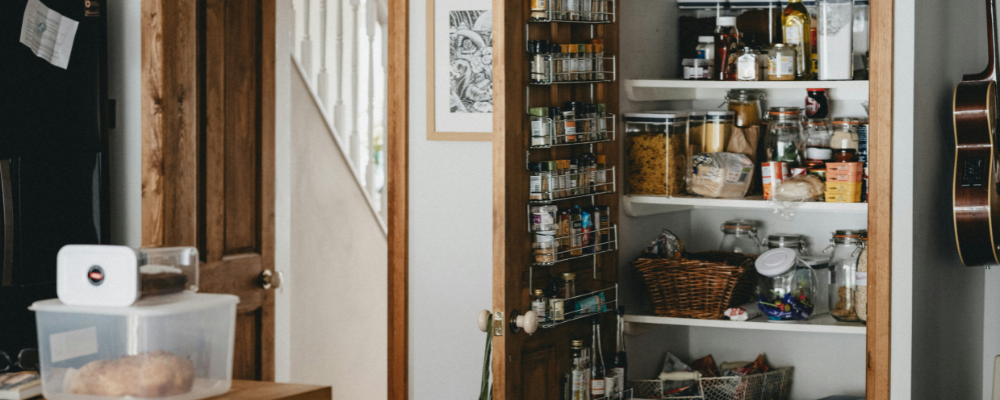
Spring Kitchen Clean Out
— By Kathy Savoie, Extension Educator, University of Maine Cooperative Extension
Spring is here at last! It’s great to open the windows and let in the warm, fresh air of a new season. Sometimes the change in seasons even makes us want to clean out the house!
Pantry Clean-Out Tips
When you spring clean, check your pantry for foods that have been stored beyond their “Best By/Best Used By” date. Keep pantry goods at their best quality by storing them in clean, dry, cool (ideally between 50˚F – 70°F) cabinets—away from stove and refrigerator vents. Extremely hot (over 95°F) and cold temperatures can harm canned goods.
Here’s a breakdown of common food labels:
Best By/Best Used By: This label refers to quality, not safety. The food may not taste as fresh after this date, but it’s still safe to eat.
Use By: Found on perishable items like meat, yogurt and eggs, this label indicates peak quality. In most cases, a one-week grace period applies if stored properly.
Sell By: This tells stores how long to display the product. Food is usually still safe for several days to weeks after this date if stored correctly.
Expiration Date: The only food legally required to have an expiration date in the U.S. is infant formula.
Never use pantry goods with
- cans that are leaking, bulging, or badly dented,
- a foul odor,
- cracked jars, or jars with loose or bulging lids, or
- a container that spurts liquid when you open it.
Throw out any food you suspect is spoiled. To help you identify if a can of food is safe to eat, use UMaine Cooperative Extension’s publication “Is This Can Safe to Use?”. In general, most commercially canned foods are safe to eat for several years if they are stored properly. Follow these guidelines:
- Use low-acid canned goods within two to five years. These include canned meat and poultry, stews, soups (except tomato), pasta products, potatoes, corn, carrots, spinach, beans, beets, peas, and pumpkin.
- Use high-acid canned goods within 12 to 18 months. These include tomato products, fruits, sauerkraut, and foods in vinegar-based sauces or dressings.
- Use all home-canned foods within one year.
Herbs and spices can get pushed to the back of the pantry and forgotten. For the best spice flavor, use spices within two to four years if they are whole, and two to three years if they are ground. Dried herbs should be used within one year for the best flavor.
What’s in Your Refrigerator & Freezer?
The temperature of your freezer and refrigerator should be checked often. Your refrigerator must stay below 40°F to keep your food safe. You may need to adjust the controls when the season changes. For example, a refrigerator set to stay at 40°F in the winter may get warmer in the summer. Food that has been refrigerated at temperatures above 40°F should not be eaten.
Take some time to see what’s in your refrigerator. Shelves and compartments can hide half-used and long-forgotten condiments. Throw away any that are beyond the below storage guidelines.
| Food | Store No Longer Than |
| Barbecue sauce | 4 months |
| Ketchup, cocktail, and chili sauce | 6 months |
| Mayonnaise | 2 months |
| Mustard | 1 year |
| Pickles | 1 to 2 months |
| Salad dressings | 3 months |
| Salsa | 1 month |
| Home-canned high acid foods (jams, pickles, relish) |
2 weeks |
Your freezer should stay at 0°F or below. Get in the habit of putting the date on foods before you put them in the freezer. A permanent marker is a great tool for date stamping the package. Remember to use the oldest items first, as long as they are within the following storage guidelines for freezer foods.
Frozen Food
| Food | Store No Longer Than |
| Chicken or turkey, whole | 12 months |
| Chicken or turkey, parts | 9 months |
| Ground meat | 3 to 4 months |
| Sausage | 1 to 2 months |
| Hot dogs | 1 to 2 months |
| Bacon | 1 month |
| Lean fish (cod, flounder, haddock) | 6 months |
| Fatty fish (bluefish, mackerel, salmon) | 2 to 3 weeks |
| Shrimp, scallops, shucked clams, mussels, and oysters | 3 to 6 months |
| Cooked shellfish | 3 months |
If frozen food gets “freezer burn” it is still safe to eat. It is just dry in spots but may have “off” flavors. Remember to cut away freezer-burned portions either before or after cooking the food.
For more information on storage guidelines, visit the FoodKeeper App through Foodsafety.gov.
